
|
The WCON-07 and TCON-17 Lens Attachments for the Olympus C-5050Z Camera |

| My other pages related to the Olympus C-5050Z, C-5060WZ, and X-7070WZ |
|
In the early Spring of 2003 Olympus released two new auxiliary lenses for their C-5050Z camera (the lenses will work equally well with the C-4000, C-4040, and the older 20x0 and 30x0 series). In place of the discontinued WCON-08 and TCON-14 (with focal length multipliers of 0.8x and 1.4x), they now offer the WCON-07 and TCON-17 (with multipliers, yes, you guessed right, of 0.7x and 1.7x). This is a welcome change, for two reasons:
Here are the basic specs of both lenses at a glance: |
| Model | WCON-07 | TCON-17 | Notes |
|---|---|---|---|
| Focal length multiplier | 0.7x | 1.7x | |
| Equivalent focal length (mm) | 24.5 | 178.5 | [1] |
| Elements/Groups | 4/4 | 5/3 | |
| Diameter/Length (mm) | 99/47 | 80/75 | |
| Weight (g) | 225 | 260 | |
| Rear mount thread (mm) | 55 | 55 | |
| Front filter thread (mm) | none | none | |
| Minimum focus distance, cm | 70/8 | 200/40 | [3] |
| Price paid | $160 | $130 | [2] |
|
Notes:
Now, let me go step-by-step through the basics of both lenses. Mechanical The lenses appear to be well-made and finished in what looks black aluminum, but actually is some kind of plastic compound (possibly polycarbonate). Actually, it took me some time to discover that. (The previous WCON and TCON attachments for the E-10/E-20 series had aluminum barrels. In spite of much lower machining costs, the new lenses sell for approximately the same price as their E-10/E-20 equivalents; I'm wondering who pockets the difference.) The front barrel rim (more prominent on the 0.7x) protrudes ahead just enough to protect the front glass surface from scratching when the lens rests on its face. Both are quite light (see table); taken together they add just below 0.5 kg (1.1 lb) to the weight of your gadget bag, or the weight of my TCON-14B for the Oly E-20. | ||
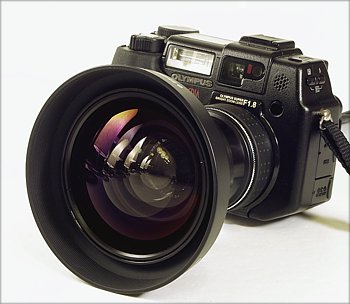
|
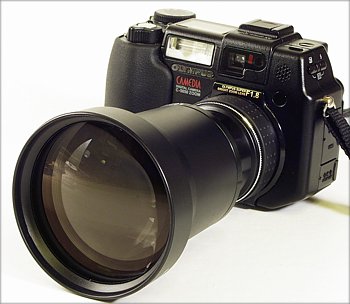
| |
|
In spite of being front-heavy, the camera-lens ensemble still can be operated one-handed if needed. It looks like a nerdy Ruby Goldberg contraption (which it is), but this is something you will have to live with. Each lens comes with front and rear push-on caps made of plastic. I consider this a cheap solution, especially the rear caps, not having much grip on the rear thread and coming off very easily. Mounting on the camera WCON-07 and TCON-17 both have a rear thread of 55 mm. Mounting them on a camera, over the built-in lens, requires the use of a lens adapter tube. There are two such adapters readily available: CLA-1 from Olympus (not to be confused with the CLA-4 for their C7xx camera series) and the OLYC3000AD from Tiffen. (Both are in stock at B&H.) Both adapters have a 41 mm thread at the rear end, which screws into the rubberized ring surrounding the lens near the camera body; at the front end each provides a 43 mm thread. This means that our attachment lenses will also require a 43-55 mm step-up ring, readily available from Olympus or (less expensively) from many third-party makers. Note of 2004: The plastic rear threads, in spite of (moderate) use over the last year, did not develop any problems. They could, if I have used the lenses more often; I would prefer to have metal mounts. The pictures below, using the same scale, show both lenses mounted on the '5050 with use of the CLA-1 tube and a 43-55 mm ring. | ||
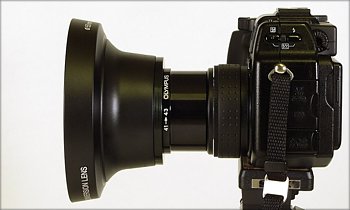
|
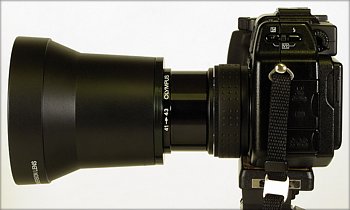
| |
|
As with any camera with an optical-viewfinder, using attachment lenses comes at a price: you lose the use of the built-in flash and, more importantly, of the optical finder. SLRs or cameras with electronic, eye-level viewfinders (those I really dislike for many reasons) do not suffer from the latter limitation. This is painful not only from the convenience viewpoint, but also for two more reasons. First, the rear LCD monitor is usually not very readable in bright daylight. Second, holding the camera in extended arms in front of you makes it significantly more shake-prone; a higher chance of blurred pictures, especially with the longer focal length and at lower light levels. The seemingly trivial subject of adapter tubes is the subject of another article; here let me just say that I would rather recommend using the Tiffen tube instead of the (shown) Olympus CLA-1, although both will serve their purpose well. Optical With the 4/4 and 5/3 element/group construction these are not cheapo lenses. Glass surfaces are multicoated to reduce light loss and, more importantly, internal reflections which cause glare effects and loss of contrast. I would expect a respectable performance from both, and the image samples, indeed, show it. I have recently seen a 2-element, wide-angle (0.6x) attachment by a third-party maker. No amount of advertising will change the laws of physics; a two-element lens (especially wide-angle) cannot correct all optical aberrations to any acceptable degree; not today or within the predictable future. These are usually lenses developed for entry-level video cameras of much lower resolution (and less demanding audience). Please do not ask me what I think of this or that 30-dollar bargain. Each attachment has to be used at the respective end of the camera's zoom focal length range: WCON-07 at the wide angle, TCON-17 at the tele setting. The reasons are different: the wide-angle image quality will rapidly deteriorate if you zoom in, and the TCON will cause vignetting when zoomed out. You can adjust the focal length a little if needed, but not by much. The effective aperture of the lens/attachment combination stays unaffected. This means we end up with (approximately) a 1.8/24 mm and 2.6/180 mm lenses, speaking in 35-mm film camera terms. This is nice, as I consider the 24 mm (equivalent) lens being the most useful wide angle for scenics and some interiors. On the other hand, the 180 mm length, in addition to the obvious advantage of "bringing your subject closer" also provides the shallow depth of field, useful in blurring the background in close-up portraits, and difficult to achieve on digital cameras with their small CCD sensors. Filters and hoods Neither of the new attachment lenses has a front accessory thread, so filters or hoods cannot be used, at least not easily. In case of the WCON-07 this is understandable for vignetting reasons, but for the TCON-17 I consider this a serious omission. Longer lenses usually have lower contrast, and using a hood usually improves it considerably. Using a filter to protect the lens from elements may also appeal to some. On the TCON there is even room for a filter thread, and the internal barrel rim diameter is 78 mm, not prohibitive. Why not? Focusing range The close focusing distances are given in the table above, quoted after lens instruction leaflets. If in doubt, switch into the macro mode (the flower icon without an 'S') and the camera will still focus up to infinity, albeit somewhat more slowly (see my "super macro" article for more on this). The proof is in the pictures. Here is my pond scene taken at four focal lengths (35-mm equivalent, therefore denoted as EFL): 35 and 105 mm (both ends of the camera's lens without any attachments), and then 24 and 180 mm (using WCON-07 and TCON-17, respectively. All pictures were shot from a tripod at ISO 64, in aperture priority mode with EV compensation as shown, using default sharpness, contrast, and saturation settings. Images were saved as SHQ JPEG files. For each shot, a reduced and re-sharpened full frame is shown at the left. At the right is a cropped 1:1 (full pixel size) sample from the frame center, without any postprocessing, and re-saved at low compression. | ||
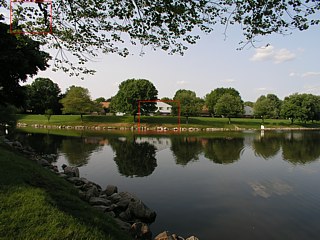
|
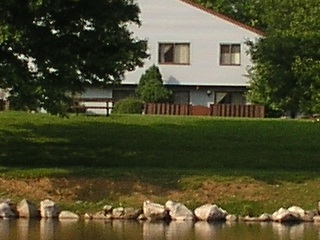
| |
|
EFL = 24 mm (F=4.9mm), F/4.0 at 1/500s (-0.3 EV); click here for full frame | ||
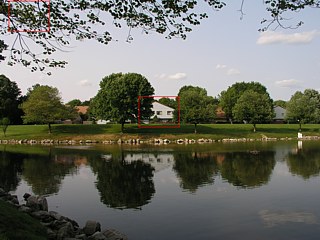
|
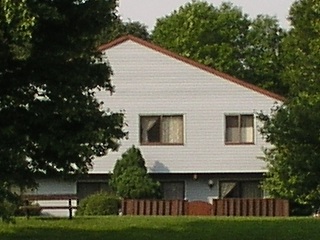
| |
|
EFL = 35 mm (F=7.1mm), F/4.0 at 1/500s (-0.3 EV); click here for full frame | ||
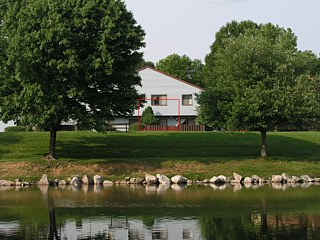
|
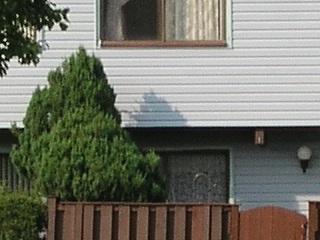
| |
|
EFL = 105 mm (F=21.3mm), F/4.0 at 1/400s (-0.7 EV); click here for full frame | ||
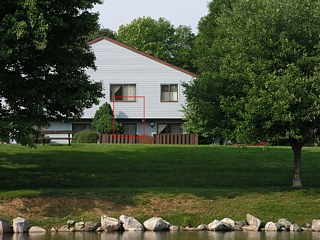
|
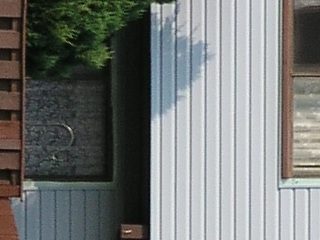
| |
|
EFL = 180 mm (F=36.2mm), F/4.0 at 1/400s (-0.7 EV); click here for full frame | ||
|
If you would prefer to look at the whole original images (and if you do not mind three-megabyte downloads), links to full versions of each picture are given in captions. For wide angle lenses it is quite interesting to have a closer look at the corners of the frame. You may expect some chromatic aberration there (which is a flaw of the lens itself, quite difficult to correct optically), but also some purple fringing (which is a flaw of the CCD itself: some sensors pick up charge from their neighbors). These effects, although different in their physical nature, result in coloration of high-contrast transitions (like dark objects versus bright sky), especially far from the image center. Here are 1:1 samples of that artifact at EFL of 24 and 35 mm: | ||
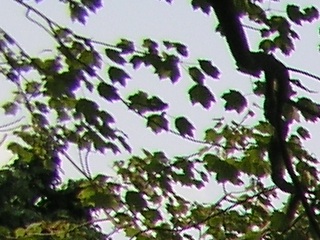
|
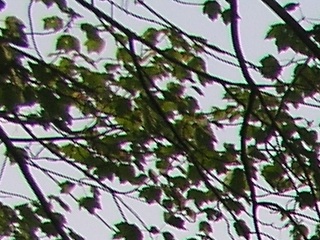
| |
|
With WCON-07: EFL = 24 mm (F=4.9mm) |
Without: EFL = 35 mm (F=7.1mm) | |
|
Indeed, for the WCON-07 (EFL = 24 mm) some chromatic aberration is visible in the far corners, decreasing dramatically towards the center. The effect is quite clear on the leaves at the left, and almost gone at the branch to the right; all this within a small fragment of the image, see the red box in the full-frame thumbnail. I still consider this a respectable performance of the lens/camera combo — maybe not as good as that of the TCON-08B on the E-20, but close, and at a wider image angle! (I think this is just chromatic aberration, with magenta spilling from highlights into shadow outwards from the center, and green — towards it. The sensor-originating purple fringing demonstrates itself as a magenta spill in all directions.) For the bare lens at the wide end (EFL = 35 mm) I had to magnify the sample 2:1 pixel size to see any amount of the effect. Of course, at a higher contrast (brighter sky) I am sure we could see more of it. Overall, I am happy with the optical quality of images produced by the WCON-07, and very happy with that of the TCON-17. The latter seems to be as good as the TCON-14B for the E-10/E-20 series, and this is something; both contrast and sharpness are most pleasing. Well, this shows again that it is easier to design a tele lens than a wide-angle one, facts of life. More samples For those who, since the original posting of this report, asked for samples using my regular reference subject, here is another series (and yes, you owe me $23 for the car wash). All pictures were shot at F/4 in the aperture priority mode with a -0.3 EV exposure compensation. Also, here I used my regular settings of in-camera image processing: sharpness at -2, contrast at -1, saturation at +1. In all cases I was trying to fill the frame horizontally with the car trunk, but differences in the central image magnification were hard to avoid. | ||
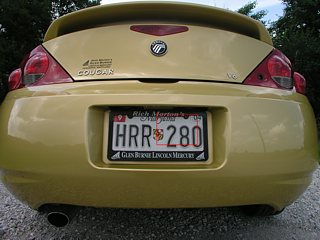
|
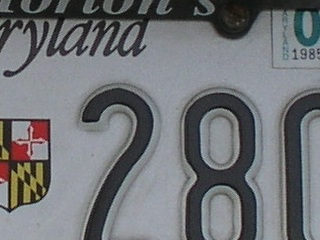
| |
|
EFL = 24 mm (F=4.9mm) | ||
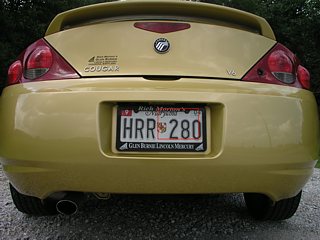
|
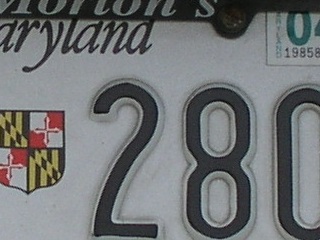
| |
|
EFL = 35 mm (F=7.1mm) | ||
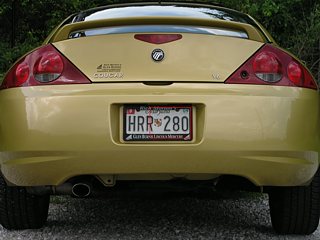
|
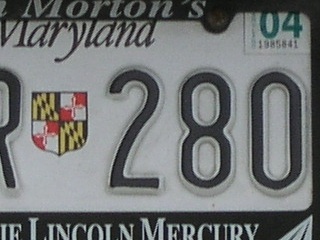
| |
|
EFL = 105 mm (F=21.3mm) | ||
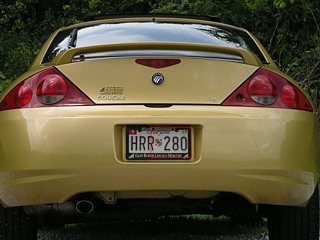
|
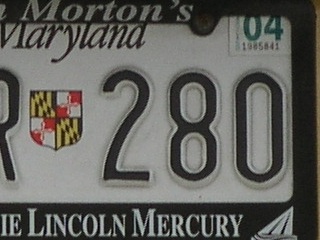
| |
|
EFL = 180 mm (F=36.2mm) | ||
|
Wow. Both lenses did an outstanding job here, just plain eye candy. The loss of image detail caused by all the extra glass is, for all practical purposes, impossible to spot, at least near the center of the frame. Both also hold the contrast very well, thank you, what was a nice surprise in case of the EFL = 180 mm. The bottom line My experience with the older Olympus lens attachments for compact cameras, WCON-08 and TCON-18, was quite limited and, while not really disappointing, not good enough to buy them (true, most others were worse). This time I am glad to report that their replacements, WCON-07 and TCON-17, seem to be worth recommending for a serious user of the '5050. Optically, the wide-angle is good, and the tele — maybe even better (whatever that means in my subjective terms). Mechanically, both lenses are nicely made and finished (except for the cheap rear plastic caps). They are also quite light: the whole shebang, i.e., the '5050 and both lenses, will weigh just a little more than a kilo — not bad for those mountain hikes. Although I'm recommending both lenses, you may be on a limited budget, having to choose just one, at least for now. In this case I would go for the WCON-07, in spite of the better image quality of the TCON-17. This may be personal, but in general use I'm usually missing the wide end more often, and the EFL of 24 mm is nothing to sniff at. See also
| ||

| My other pages related to the Olympus C-5050Z, C-5060WZ, and X-7070WZ |
| Home: wrotniak.net | Search this site | Change font size |
| Posted 2003/05/30; last updated 2007/08/13 | Copyright © 2003-2007 by J. Andrzej Wrotniak. |